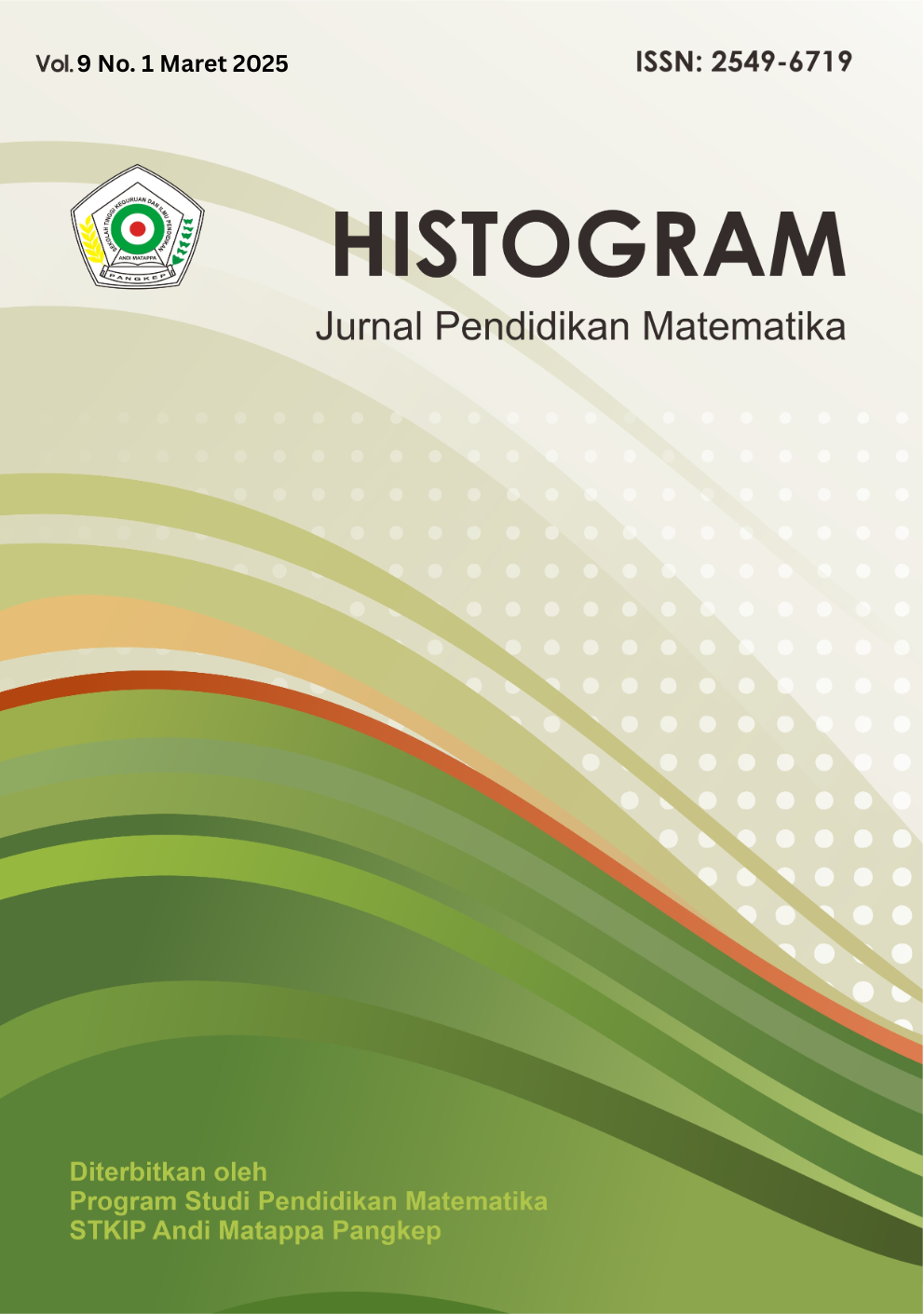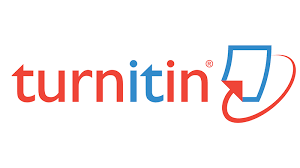MENINGKATKAN KEMAMPUAN SPASIAL MENGGUNAKAN MODUL PEMBELAJARAN GEOMETRI BERBANTUAN GEOGEBRA
DOI:
https://doi.org/10.31100/histogram.v9i1.3873Kata Kunci:
Geometri, GeoGebra, Kemampuan Spasial, ModulAbstrak
This research is development research by applying the 4-D development model (Four D Model) proposed by Thiagarajan to produce learning modules. This model consists of four main phases, namely defining, module design, development module, and deployment module. The research aims to analyze the results of developing modules assisted by GeoGebra that are valid, practical, effective and analyze their influence on students' spatial abilities. The results of the development of GeoGebra-assisted geometry learning tools are valid, practical and effective modules. The module validity coefficient is 4.53 with a very valid category. The practicality criteria were met at 84.76 in the very practical category. The effectiveness criteria were met from the results of observing student activities with 3.47 in the active category, the response questionnaire was very positive with 4.54, meanwhile for the results of the student spatial ability test, 100% of students scored more than 70. With a gain value of 3.805. Based on the results of this research, there is a significant influence of Geogebra-assisted learning modules on improving students' spatial abilities.
Referensi
Akayuure, P., Asiedu-Addo, S. K., & Alebna, V. (2016). Investigating the Effect of Origami Instruction on Preservice Teachers’ Spatial Ability and Geometric Knowledge for Teaching. International Journal of Education in Mathematics, Science and Technology, 4(3), 198–209. https://doi.org/10.18404/ijemst.78424
Al-Azka, H. H., Setyawati, R. D., & Albab, I. U. (2019). Pengembangan Modul Pembelajaran. Imajiner: Jurnal Matematika dan Pendidikan Matematika, 1(5), 224–236. https://doi.org/10.26877/imajiner.v1i5.4473
Arsyad, N. (2016). Model Pembelajaran Menumbuh Kembangkan Kemampuan Metakognitif. Pustaka Refleksi.
Batubara, I. H. (2020). Peningkatan Kemampuan Pemecahan Masalah Matematik melalui Metode Penemuan Terbimbing Berbantuan Sofware GeoGebra. Journal Mathematics Education Sigma [JMES], 1(1), 24–28. https://doi.org/10.30596/jmes.v1i1.4015
Delita, F., Berutu, N., & Nofrion, N. (2022). Online Learning: The Effects of using E-Modules on Self-Efficacy, Motivation and Learning Outcomes. Turkish Online Journal of Distance Education, 23(4), 93–107. https://doi.org/10.17718/tojde.1182760
Fitriana, R., Rinaldi, A., & Suherman, S. (2021). GeoGebra pada Aplikasi Sigil sebagai Pengembangan E-Modul Pembelajaran Matematika. Prisma, 10(1), 106–120.
Herman, H., Zalukhu, A., Hulu, D. B. T., Zebua, N. S. A., Manik, E., & Situmorang, A. S. (2023). Augmented Reality (AR) pada GeoGebra Meningkatkan Kemampuan Spasial dan Pemecahan Masalah Matematis pada Materi Dimensi Tiga. Journal on Education, 5(3), 6032–6039. https://jonedu.org/index.php/joe/article/view/1368
Japa, N., Suarjana, I. M., & Widiana, W. (2017). Media GeoGebra dalam Pembelajaran Matematika. International Journal of Natural Science and Engineering, 1(2), 40–47. https://doi.org/10.23887/ijnse.v1i2.12467
Jumriani, & Rahman, A. (2023). Kemampuan Spasial dalam Menyelesaikan Soal Geometri. Tautologi: Journal of Mathematics Education, 1(2), 95–102. https://doi.org/10.31850/tautologi.v1i2.2572
Lubis, R. P., Saputra, E., & Maysarah, S. (2023). Kemampuan Spasial dengan Model Pembelajaran SFE dan TTW pada Siswa Al-Azhar Medan. Relevan: Jurnal Pendidikan Matematika, 3(1), 65–69. https://ejournal.yana.or.id/index.php/relevan/article/view/806
Marunic, G., & Glazar, V. (2015). Improvement and Assessment of Spatial Ability in Engineering Education. Engineering Review, 34(2), 139–150. https://engineeringreview.org/index.php/ER/article/view/365?articlesBySimilarityPage=2
Ningsih, I., & Haerudin. (2019). Kemampuan Spasial Matematis Siswa SMP Kelas VIII pada Materi Bangun Ruang Sisi Datar. Prosiding Seminar Nasional Matematika dan Pendidikan Matematika Sesiomadika 2019, 623–631. https://journal.unsika.ac.id/index.php/sesiomadika/article/view/2662/1904
Nopiyani, D., Turmudi, & Prabawanto, S. (2016). Penerapan Pembelajaran Matematika Realistik Berbantuan GeoGebra untuk Meningkatkan Kemampuan Komunikasi Matematis Siswa SMP. Mosharafa: Jurnal Pendidikan Matematika, 5(2), 45–52. https://doi.org/10.31980/mosharafa.v5i2.356
Novianti, M., Alghozi, H. H., & Suratman, D. (2024). GeoGebra sebagai Penunjang Pembelajaran dan Peningkatan Kemampuan Spasial. Jurnal AlphaEuclidEdu, 5(1), 25–31. https://doi.org/10.26418/ja.v5i1.83116
Nyeneng, I. D. P., & Suana, W. (2018). Pengembangan Perangkat Flipped Classroom pada Mata Pelajaran Fisika SMA. JPF (Jurnal Pendidikan Fisika) FKIP UM Metro, 6(2), 159–174. https://ojs.fkip.ummetro.ac.id/index.php/fisika/article/view/1193
Pramana, B. W. A., Susanto, Suwito, A., Lestari, N. D. S., & Murtikusuma, R. P. (2022). Pengembangan E-Modul Berbantuan GeoGebra pada Materi Transformasi Geometri SMA. GAUSS: Jurnal Pendidikan Matematika, 5(2), 1–14. https://doi.org/10.30656/gauss.v5i2.5694
Ramful, A., Lowrie, T., & Logan, T. (2017). Measurement of Spatial Ability: Construction and Validation of the Spatial Reasoning Instrument for Middle School Students. Journal of Psychoeducational Assessment, 35(7), 709–727. https://doi.org/10.1177/0734282916659207
Rhilmanidar, R., Ramli, M., & Ansari, B. I. (2020). Efektivitas Modul Pembelajaran Berbantuan Software GeoGebra pada Materi Bangun Ruang Sisi Datar. Jurnal Didaktik Matematika, 7(2), 142–155. https://doi.org/10.24815/jdm.v7i2.17915
Senjayawati, E., Akbar, E. R., & Fauziyyah, H. (2023). Pengembangan Modul Ajar Geometri Analitik Berbasis Cognitive Load Theory untuk Meningkatkan Berpikir Reflektif Matematik Mahasiswa. AKSIOMA: Jurnal Program Studi Pendidikan Matematika, 12(1), 1074–1084. https://doi.org/10.24127/ajpm.v12i1.6663
Siswanto, R. D., & Kusumah, Y. S. (2017). Peningkatan Kemampuan Geometri Spasial Siswa SMP melalui Pembelajaran Inkuiri Terbimbing Berbantuan GeoGebra. Jurnal Penelitian dan Pembelajaran Matematika, 10(1), 42–51. https://doi.org/10.30870/jppm.v10i1.1196
Sugandi, A. I., Sofyan, D., Linda, L., & Sari, D. R. (2022). Pengembangan Modul Geometri Analitik Berbasis Strategi React Berbantuan GeoGebra untuk Melatihkan Kemampuan Berpikir Kritis. AKSIOMA: Jurnal Program Studi Pendidikan Matematika, 11(2), 850–859. https://doi.org/10.24127/ajpm.v11i2.4963
Sugiarni, R., Alghifari, E., & Ifanda, A. R. (2018). Meningkatkan Kemampuan Spasial Matematis Siswa dengan Model Pembelajaran Problem Based Learning Berbantuan GeoGebra. KALAMATIKA Jurnal Pendidikan Matematika, 3(1), 93–102. https://doi.org/10.22236/KALAMATIKA.vol3no1.2018pp93-102
Utami, C. (2020). Kesalahan Siswa dalam Menyelesaikan Soal Kemampuan Spasial Matematis. Al-Khwarizmi: Jurnal Pendidikan Matematika dan Ilmu Pengetahuan Alam, 8(2), 123–132. https://doi.org/10.24256/jpmipa.v8i2.1177
Wijaya, J. E., & Vidianti, A. (2020). The Effectiveness of using Interactive Electronic Modules on Student Learning Outcomes in Education Innovation Course. Proceedings of the International Conference on Progressive Education (ICOPE 2019). https://doi.org/10.2991/assehr.k.200323.096
Unduhan
Diterbitkan
Terbitan
Bagian
Citation Check
Lisensi
Hak Cipta (c) 2025 Abdul rahman, Henra Ahmad

Artikel ini berlisensi Creative Commons Attribution-NonCommercial-NoDerivatives 4.0 International License.
Please find the rights and licenses in Histogram: Jurnal Pendidikan Matematika. By submitting the article/manuscript, the author(s) accept this policy.
1. License
The non-commercial use of the article will be governed by the Creative Commons Attribution license as currently displayed on Creative Commons Attribution-ShareAlike 4.0 International.
2. Author's Warranties
The author warrants that the article is original, written by a stated author(s), has not been published before, contains no unlawful statements, does not infringe the rights of others, is subject to copyright that is vested exclusively in the author and free of any third party rights, and that any necessary written permissions to quote from other sources have been obtained by the author(s).
3. User Rights
Histogram: Jurnal Pendidikan Matematika's spirit is to disseminate articles published for free. Under the Creative Commons license, Histogram: Jurnal Pendidikan Matematika permits users to copy, distribute, display, and perform the work for non-commercial purposes only. Users will also need to attribute authors and Histogram: Jurnal Pendidikan Matematika when distributing works in the journal.
4. Rights of Authors
Authors retain all their rights to the published works, such as (but not limited to) the following rights;
- Copyright and other proprietary rights relating to the article, such as patent rights,
- The right to use the substance of the article in one's future works, including lectures and books,
- The right to reproduce the article for one's purposes,
- The right to self-archive the article,
- The right to enter into separate, additional contractual arrangements for the non-exclusive distribution of the article's published version (e.g., post it to an institutional repository or publish it in a book), with an acknowledgment of its initial publication in this journal (Histogram: Jurnal Pendidikan Matematika).
5. Co-Authorship
If other authors jointly prepared the article, any author submitting the manuscript warrants that all co-authors have authorized them to agree on this copyright and license notice (agreement) on their behalf and agree to inform their co-authors of the terms of this policy. Histogram: Jurnal Pendidikan Matematika will not be held liable for anything arising from the author(s) internal dispute. Histogram: Jurnal Pendidikan Matematika will only communicate with the corresponding author.
6. Royalties
This agreement entitles the author to no royalties or other fees. To such an extent that it is legally permissible, the author waives their right to collect royalties relative to the article regarding any use by Histogram: Jurnal Pendidikan Matematika.
7. Miscellaneous
Histogram: Jurnal Pendidikan Matematika will publish the article (or have it published) in the journal if the editorial process is completed. Histogram: Jurnal Pendidikan Matematika h editors may modify the article to a style of punctuation, spelling, capitalization, referencing, and usage that deems appropriate. The author acknowledges that the article may be published to be publicly accessible, and such access will be free of charge for the readers, as mentioned in point 3.





